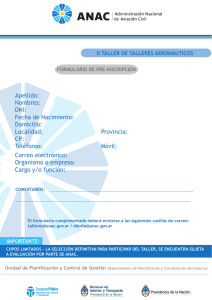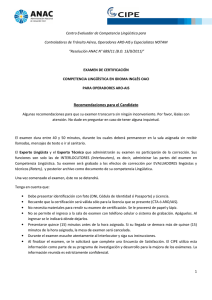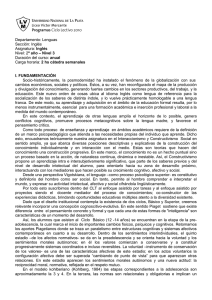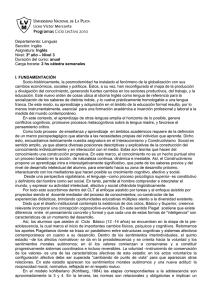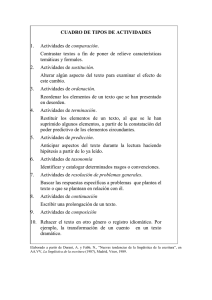Recomendaciones para el Candidato - CIPE
Anuncio
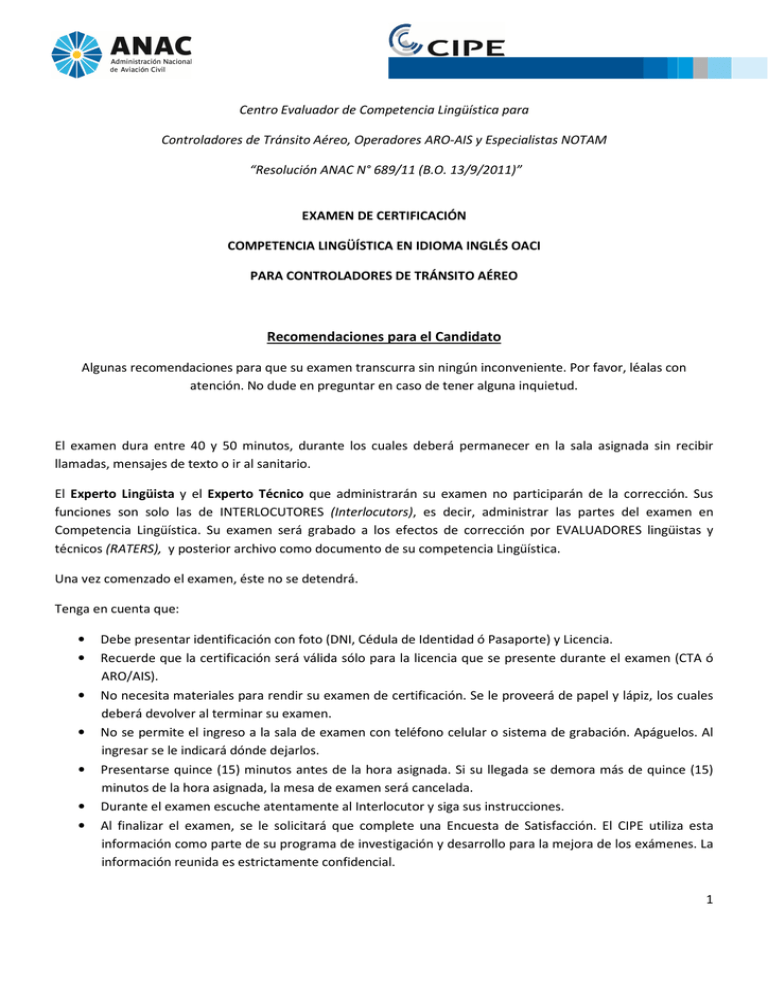
Centro Evaluador de Competencia Lingüística para Controladores de Tránsito Aéreo, Operadores ARO-AIS y Especialistas NOTAM “Resolución ANAC N° 689/11 (B.O. 13/9/2011)” EXAMEN DE CERTIFICACIÓN COMPETENCIA LINGÜÍSTICA EN IDIOMA INGLÉS OACI PARA CONTROLADORES DE TRÁNSITO AÉREO Recomendaciones para el Candidato Algunas recomendaciones para que su examen transcurra sin ningún inconveniente. Por favor, léalas con atención. No dude en preguntar en caso de tener alguna inquietud. El examen dura entre 40 y 50 minutos, durante los cuales deberá permanecer en la sala asignada sin recibir llamadas, mensajes de texto o ir al sanitario. El Experto Lingüista y el Experto Técnico que administrarán su examen no participarán de la corrección. Sus funciones son solo las de INTERLOCUTORES (Interlocutors), es decir, administrar las partes del examen en Competencia Lingüística. Su examen será grabado a los efectos de corrección por EVALUADORES lingüistas y técnicos (RATERS), y posterior archivo como documento de su competencia Lingüística. Una vez comenzado el examen, éste no se detendrá. Tenga en cuenta que: • • • • • • • Debe presentar identificación con foto (DNI, Cédula de Identidad ó Pasaporte) y Licencia. Recuerde que la certificación será válida sólo para la licencia que se presente durante el examen (CTA ó ARO/AIS). No necesita materiales para rendir su examen de certificación. Se le proveerá de papel y lápiz, los cuales deberá devolver al terminar su examen. No se permite el ingreso a la sala de examen con teléfono celular o sistema de grabación. Apáguelos. Al ingresar se le indicará dónde dejarlos. Presentarse quince (15) minutos antes de la hora asignada. Si su llegada se demora más de quince (15) minutos de la hora asignada, la mesa de examen será cancelada. Durante el examen escuche atentamente al Interlocutor y siga sus instrucciones. Al finalizar el examen, se le solicitará que complete una Encuesta de Satisfacción. El CIPE utiliza esta información como parte de su programa de investigación y desarrollo para la mejora de los exámenes. La información reunida es estrictamente confidencial. 1 Centro Evaluador de Competencia Lingüística para Controladores de Tránsito Aéreo, Operadores ARO-AIS y Especialistas NOTAM “Resolución ANAC N° 689/11 (B.O. 13/9/2011)” Preguntas frecuentes ¿Quién puede presentarse al examen de certificación en competencia lingüística OACI? Todo aquel Controlador de Tránsito Aéreo, Operador ARO-AIS o Especialista NOTAM que posea Licencia. ¿Cómo me inscribo para el examen de certificación en competencia lingüística OACI? • Si la inscripción es directa, es decir, sin cursar, enviando un mail a [email protected] con copia a [email protected] • Si es alumno del Curso 4B Aviation English for ATCOs Intensive Course, su inscripción se generará desde el CIPE. • ¿Debo abonar derecho de examen? El examen de certificación es sin cargo para Controladores de Tránsito Aéreo, Operadores ARO-AIS y Especialistas NOTAM cumpliendo funciones en ANAC. ¿Puedo elegir fecha de examen? Se efectuarán llamados a examen periódicamente. El candidato puede seleccionar la fecha y horario de su conveniencia y se le asignará un turno. El calendario anual de llamados está disponible en http://cipe.anac.gob.ar/cipe/web/index.php/1/629/certificaciones/certificacion-en-competencialingistica ¿Qué pasa si no me presento en el turno asignado? Si la no concurrencia es debidamente justificada y comprobada, se le asignará un nuevo turno. De lo contrario, se lo incorporará en lista de espera hasta que se registren turnos libres. ¿Cuándo obtengo el resultado de mi examen? El proceso de corrección de su examen está a cargo de un equipo de Expertos Lingüistas y Expertos Técnicos, quienes deberán cumplimentar distintas instancias de corrección. Por lo tanto, el resultado estará disponible a los quince (15) días hábiles de haber rendido el examen. ¿Cuál es el nivel mínimo de certificación? Nivel 4 Operacional, de acuerdo a los Descriptores Holísticos OACI y la Escala de Niveles, Documento 9835 Ediciones 2004 y 2010. Hay otros dos niveles de certificación: Nivel 5 Extendido y Nivel 6 Experto. En caso de no haber alcanzado el Nivel 4 Operacional, ¿cuándo puedo volver a presentarme? En un tiempo prudencial (no menor a tres (3) meses) que le permita mejorar las observaciones efectuadas en la devolución (feedback), al cual Usted accederá al momento de retirar el resultado. 2 Centro Evaluador de Competencia Lingüística para Controladores de Tránsito Aéreo, Operadores ARO-AIS y Especialistas NOTAM “Resolución ANAC N° 689/11 (B.O. 13/9/2011)” En caso de haber alcanzado algunos de los niveles de certificación, ¿recibo algún certificado? Recibirá una CONSTANCIA extendida por el CIPE del nivel logrado, que deberá presentar ante la Dirección de Licencias y Habilitaciones para la correspondiente inscripción del nivel obtenido en su licencia. Recibirá un CERTIFICADO CIPE del nivel alcanzado para su tenencia personal. ¿Puedo tener acceso a mi examen grabado? No. El contenido del mismo es estrictamente confidencial y permanece bajo la custodia y protección del CIPE hasta el momento de la recertificación. Si no estoy de acuerdo con el nivel obtenido, ¿puedo solicitar revisión del resultado? Si. Puede solicitar la revisión por mail a la casilla [email protected] o personalmente en el CIPE presentando la nota correspondiente. Si resido en el interior del país, ¿tengo que trasladarme a Ezeiza para rendir el examen de certificación? No necesariamente. Los INTERLOCUTORES se movilizarán a aquellas provincias que logren reunir como mínimo cinco (5) candidatos para rendir. El pedido debe efectuarse al Director del CIPE siguiendo el protocolo habitual. El CIPE puede utilizar la información por Usted provista al momento de la inscripción, así como también el contenido de su examen de certificación solo a los efectos de control de calidad e investigación y desarrollo de mejoras de futuros exámenes de certificación en competencia lingüística OACI, asegurándole total confidencialidad. 3 Centro Evaluador de Competencia Lingüística para Controladores de Tránsito Aéreo, Operadores ARO-AIS y Especialistas NOTAM “Resolución ANAC N° 689/11 (B.O. 13/9/2011)” EXAM FORMAT LANGUAGE PROFICIENCY TEST FOR AIR TRAFFIC CONTROLLERS (Sample Version) The role of both interlocutors (the Language Expert - LE- and the Technical Expert-SME) is just to interact successfully in the English language with the candidate. The candidate’s performance will not be assessed by the interlocutors. The candidate’s performance will be assessed by two/three RATERS complying with ICAO LPRs (Language Proficiency Requirements). PART A: ONE-TO-ONE INTERACTION SECTION 1: Personal Interview (5 minutes) The candidate is expected to be able to speak about his/her professional life. The interlocutor may ask him/her some related questions. Refer to Appendix B for some audio and questions samples. PART A: ONE-TO-ONE INTERACTION SECTION 2: Aviation Related Topics (5 minutes) The candidate is expected to be able to speak about an aviation-related topic provided in a card he/she will have to choose. The interlocutor may ask him/her some related questions. Refer to Appendix B for some samples. PART A: ONE-TO-ONE INTERACTION SECTION 3: Case Study Reports (10 minutes) The candidate is expected to be able to talk about what he/she has understood from an aviation-related recording after listening to it twice. The candidate will be allowed to take down notes. The interlocutor may ask him/her some related questions. Refer to Appendix B for a sample recording and possible further questions. 4 Centro Evaluador de Competencia Lingüística para Controladores de Tránsito Aéreo, Operadores ARO-AIS y Especialistas NOTAM “Resolución ANAC N° 689/11 (B.O. 13/9/2011)” PART B SECTION 1: Listening for specific information (5 minutes) During this part of the exam the candidate will be presented with different exchanges between pilots and controllers from which he/she will have to extract the correct information to answer multiple choice questions after listening to each once. Each conversation has been selected from a wide variety of accents in order to check comprehension. After each exchange, the interlocutor will request the corresponding answer. Refer to Appendix A for sample questions and to Appendix B for audio samples. PART B SECTION 2: Listening for detailed information (5 minutes) This part of the exam is designed to measure listening skill in voice-only context, and the ability to speak about what has been understood. The candidate will listen to six short communications between pilots and air traffic controllers. Each recording will be played twice. Immediately after each communication, the interlocutor will ask some questions. Refer to Appendix B for audio and questions samples. PART B SECTION 3: Simulation (15 minutes) This part of the test simulates radiotelephony communications. The task is designed to assess language proficiency on the work position. The SME will take the role of the pilot. Technical knowledge will not be assessed. The candidate is presented with a scenario in which she/he will have to hold a communication in routine and nonroutine situations, in different phases of the flight, based on the unit/sector he/she works in. The test is designed to evaluate the candidate in the job environment, and even though standard phraseology is used during the simulation, it is not assessed. Refer to Appendix B for possible scenarios. 5 Centro Evaluador de Competencia Lingüística para Controladores de Tránsito Aéreo, Operadores ARO-AIS y Especialistas NOTAM “Resolución ANAC N° 689/11 (B.O. 13/9/2011)” APPENDIX A CANDIDATE’S ANSWER SHEET PART B – SECTION 1 1- What was the instruction? a) Turn right onto runway 22R b) Turn right and cross runway 22R c) Turn left next intersection d) Turn left and cross runway 22 R 2- What was the wind? a) 250 at 10 b) 200 at 7 c) 020 at 7 d) 070 at 2 3- What flight level was the traffic leaving? a) b) c) d) 370 380 400 100 4- What was the assigned speed for jet blue 852? a) Not more than 180 knots b) Not less than 180 knots 6 Centro Evaluador de Competencia Lingüística para Controladores de Tránsito Aéreo, Operadores ARO-AIS y Especialistas NOTAM “Resolución ANAC N° 689/11 (B.O. 13/9/2011)” c) Not less than 160 Knots d) 250 knots PART B – SECTION 2 1- …………………………………………………………………………………. …………………………………………………………………………………… 2- …………………………………………………………………………………… …………………………………………………………………………………… 3- …………………………………………………………………………………… …………………………………………………………………………………… 4- ………………………………………………………………………………….. 7 Centro Evaluador de Competencia Lingüística para Controladores de Tránsito Aéreo, Operadores ARO-AIS y Especialistas NOTAM “Resolución ANAC N° 689/11 (B.O. 13/9/2011)” APPENDIX B PART A – SECTION 1 Sample questions General Personal Info Work information (Present) Work information (Past) Hypothezing Giving advice and opinions Talking about the future Tell us about yourself Where do you work? Why did you become an ATCO? What would you change in your workplace What do you like most about your job? What do you see yourself doing in ten years´ time? Tell us about a typical day in your life Do you like working there? Why? Why not? Was anyone in your family an ATCO? What technological advances would you need in your workplace? What do you dislike about your job? What are your expectations about your job for the near future? PART A – SECTION 2 Sample cards K 1.Tower and ACC L Main differences Main skills to work in each of them 3.In-flight special situations Fire on board Which sector do you work in? Have you always worked there? Would you like to change? Why? / Why not? Have you ever experienced an extreme situation at work? Can you tell us about it? What is the role of an ATCO in case of fire on board? 8 Centro Evaluador de Competencia Lingüística para Controladores de Tránsito Aéreo, Operadores ARO-AIS y Especialistas NOTAM “Resolución ANAC N° 689/11 (B.O. 13/9/2011)” PART A – SECTION 3: CASE STUDY REPORTS What’s your personal opinion about this event? What are the advantages and disadvantages of working overnight schedules? PART B – SECTION 1: Listening for specific information No further questions PART B – SECTION 2: Listening for detailed information 1. What is the situation? Is the aircraft in danger? 2. What is the pilot doing? What is the air traffic controller warning about? Why is he doing it? 3. What is the pilot trying to say with PAN PAN PAN? Why did he declare the PAN PAN PAN? 4. What is the situation? Why is the pilot saying MAYDAY? Could you tell the nature of the emergency? PART B – SECTION 3: SCENARIOS SCENARIO The communication is going to take place in EZEIZA EN-ROUTE CONTROL, there are up to four traffics in the route UW64 and UW65, UL793, UW5 and UA306. Traffic N° 1 American 908, B777, from MIA to EZE, over TODES with flight level 370, (Route: TODES, GUA, PAGON.) .Calls over TODES at 0357, estimates GUA VOR at 0420. At 0410 request Ezeiza´s weather(which is not good and Trend) 9 Centro Evaluador de Competencia Lingüística para Controladores de Tránsito Aéreo, Operadores ARO-AIS y Especialistas NOTAM “Resolución ANAC N° 689/11 (B.O. 13/9/2011)” Ezeiza is operating CAT III.After that, request deviation right of course for weather. Then, some minutes later request diversion to ROS and ROS´ weather. Traffic N° 2 FDX46, B722, from EZE to SCEL, over URINO at 0404, passing flight level 245 to flight level 360, estimating NIN VOR at 0415, NUXIM next. Request if there is any ride report of the route. Traffic N°3 N179PT, GLF5, from AER to SKBO, via ATOVO ROS ROKER, calls over ATOVO passing flight level 300 to flight level 450, deviating left of course for weather. Request route change and wants to explain it to the controller. 10
